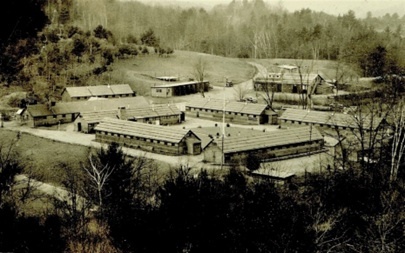EAST HAMPTON, CONNECTICUT — This year marks the 90th anniversary of the founding of the Civilian Conservation Corps (CCC).
(1)The CCC was a public works program that operated from 1933 to 1942 as part of President Franklin D. Roosevelt’s New Deal. It targeted single men, 18–25 years old, and World War I veterans in relief of families who had difficulty finding jobs during the Great Depression. The program provided unskilled manual labor in environmental conservation and the development of natural resources in rural lands.
Roosevelt proposed the Emergency Conservation Work (ECW) Act, which created what we commonly know as the Civilian Conservation Corps., on March 21, 1933, and it went through both houses of Congress and landed on the president’s desk to be signed only 10 days later.(2)
He proposed to recruit thousands of unemployed young men, enroll them in a peacetime army, and send them into battle against destruction and erosion of our natural resources. “I propose to create a Civilian Conservation Corps to be used in simple work [...] more important, however, than the material gains will be the moral and spiritual value of such work.”
On April 5, the birthday of the CCC, FDR signed the executive order creating the ECW/CCC. On April 7 the first enrollee was selected, and by April 17, the first camp, Camp Roosevelt, began operating near Luray, Virginia.
Roosevelt brought together two unused resources: the young men and the land. He promised he’d have 250,000 men in camps by the end of July that same year.
The Department of Labor, through its state and local relief offices, was responsible for the selection and enrollment of applicants. Enrollees had to be single and unemployed men aged 18–25 with families on relief. They enrolled for six months and worked a 40-hour week for $30 per month.
The government sent $25 a month home to the workers’ parents, and the men kept $5 for spending money. By July 1, 1933, there were 275,000 enrollees and 10,000 supervisory personnel in (3)1,468(4) camps. It was the fastest large-scale mobilization of men in U.S. history.
Roosevelt chose the Army to supervise the camps which consisted of approximately 200 men each. The Army moved thousands of enrollees from induction centers to working camps in record time. It used its own regular and reserve officers, together with regulars of the Coast Guard, Marine Corps, and Navy to temporarily command camps and companies.
Enrollees received good food, uniforms, shelter, and medical care. During the summer of 1933 they lived in tents; later, they moved into wooden buildings.
CCC camps were located in all 48 states and the U.S. territories. There were separate camps for white enrollees, for Black enrollees, for unemployed veterans who served in World War I, and for Native Americans, who worked on tribal lands.
* * *
More than 30 CCC camps emerged in or near Vermont towns, including Bellows Falls, Ludlow, Peru, Proctorsville/Cavendish, Weston, Wilmington, and Windsor.
Vermont was originally allocated four CCC camps, but thanks to the dynamic presence of State Forester Perry H. Merrill, the state received more assistance than other states.
Merrill’s foresight in earlier developing long-range conservation, flood control, and forest management activities, and his lobbying of CCC National Director Robert Fechner, attracted substantially increased funding of CCC activities in Vermont.
(5)Approximately 30 (6)CCC camps operated in Vermont in 1937, and between 1933 and 1942, 40,868 individuals worked in Vermont camps. Only about one-quarter of these were Vermonters (11,243). Most of the CCC men who worked in Vermont camps were from Connecticut, Rhode Island, and Massachusetts.
A camp superintendent was selected to plan, organize, and supervise projects on state and national forest land. Workers built trails, roads, campsites, and dams; stocked fish; built and maintained fire tower observers’ cabins and telephone lines; fought fires; and planted millions of trees.
* * *
The CCC disbanded in 1942 due to desertions, increased employment opportunities, changes in public opinion, lack of funding, and the need for soldiers to serve in World War II.
The program is considered by many to be one of the most successful of Roosevelt’s New Deal programs. Roosevelt’s “Tree Army” planted more than three billion trees on land made barren from fires, natural erosion, intensive agriculture, or logging. In fact, the CCC was responsible for over half the reforestation, public and private, in the nation’s history.
Enrollees constructed trails and shelters in more than 800 parks nationwide. The CCC helped to shape the modern national and state park systems we enjoy today.
CCC companies contributed to an impressive number of state and national park structures that visitors can still enjoy. The CCC developed 94 sites, including national parks, monuments, recreation areas, and historic sites.
The Civilian Conservation Corps Legacy is a national organization that is “dedicated to research, preservation, and education of future generations to create a better understanding of the CCC and its continuing contribution to American life and culture.” Anyone interested in learning about the work of the CCC Legacy and joining should visit ccclegacy.org or facebook.com/groups/ccclegacygroup.
